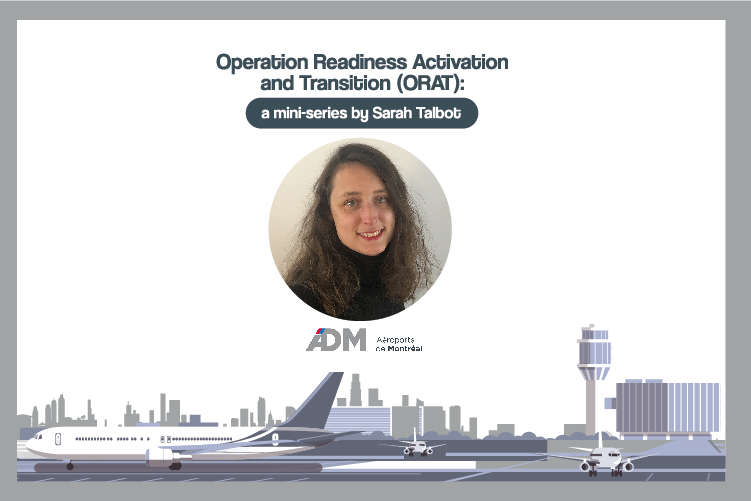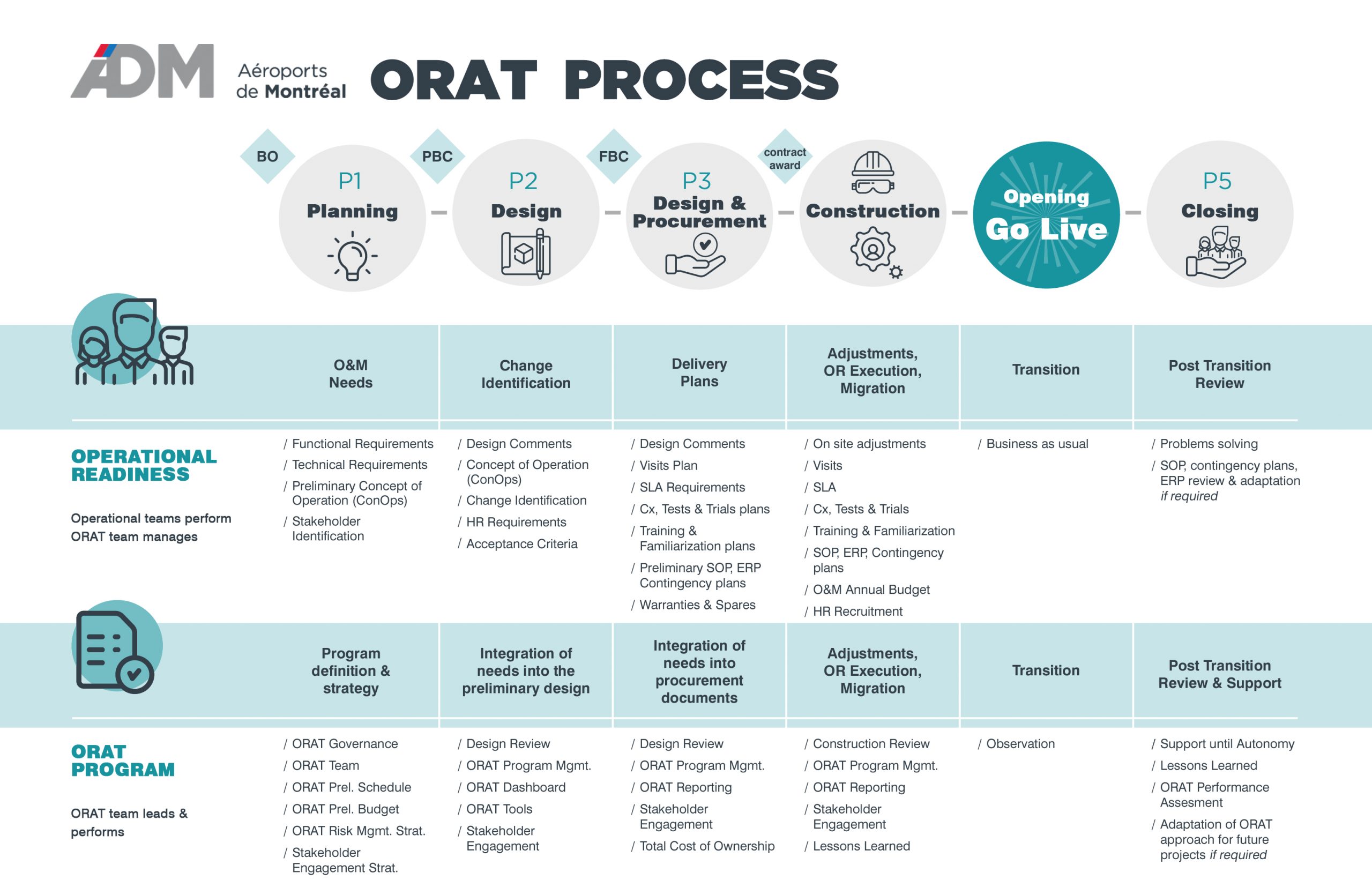Implementing ORAT during COVID-19: Montreal’s approach
- Like
- Digg
- Del
- Tumblr
- VKontakte
- Buffer
- Love This
- Odnoklassniki
- Meneame
- Blogger
- Amazon
- Yahoo Mail
- Gmail
- AOL
- Newsvine
- HackerNews
- Evernote
- MySpace
- Mail.ru
- Viadeo
- Line
- Comments
- Yummly
- SMS
- Viber
- Telegram
- Subscribe
- Skype
- Facebook Messenger
- Kakao
- LiveJournal
- Yammer
- Edgar
- Fintel
- Mix
- Instapaper
- Copy Link
Posted: 26 July 2021 | Sarah Talbot | 1 comment
In the third and final instalment of an exclusive mini-series by International Airport Review, Sarah Talbot, Project Manager and Airport Planner at ADM Aéroports de Montréal, discusses the intricacies of implementing ORAT within the airport’s major infrastructure projects.


Before COVID-19, ADM Aéroports de Montréal was facing a significant growth resulting in the need to review its infrastructure. The airport wanted the projects aligned with operational concerns and future operational concerns as the infrastructures were intended to receive the double of passengers, from 20 million to about 40 million. An ambitious capital expenditure programme was in the planning phase for Montreal-Trudeau Airport (YUL). ADM found in the Operational Readiness Activation and Transition (ORAT) approach a possibility to make the right projects.
Just before the COVID-19 pandemic hit ADM, an important infrastructure programme was starting the pre-planning phase. The timing seemed perfect, and the project director seized the opportunity to implement ORAT. As you may be aware, ADM has been drastically affected by the COVID-19 pandemic. Therefore, the airport decided to develop the ORAT programme internally, giving an employee the mandate to build and implement it. This person had a background in project management and airport planning with a propensity to involve stakeholders throughout the project.
The challenge was great: one person, no budget and numerous questioning of the infrastructure programme in a context of budget and resource cuts.
Several conditions were also favourable:
- The majority, if not all, operational teams agreed that the transfer from construction state to operational state needed to be improved
- The project had time to review its practices
- A parking garage project had been divided in two phases, one was under construction, the second was still at the design stage which gave the opportunity to test new processes and tools.

From theory to applied theory
After understanding ORAT, the first step was to apply the theory to ADM’s project management process. The goal was to improve the project process by adding operational readiness rather than starting from scratch. This approach helped infrastructure project staff understand the approach, its impact on their day-to-day job, and agree to their roles and responsibilities in the process. In major infrastructure projects, project managers remain project managers with a concern of operational readiness to integrate in their schedules and budgets, and a team manages ORAT. In smaller projects, the project manager handles the follow-ups on ORAT. In every case, the owner’s engineers contribute. Their tasks are modified to become ORAT thinkers and to improve the interface with the operational teams. This team is still in charge of architecture and engineering standards, of identifying technical requirements, of the quality insurance of external design, but their relationships with operations are extended to discuss:
- Technical and operational trainings
- Commissioning requirements
- Total cost of ownership
- Service agreements (SLA)
- Visit needs
- Equipment required to maintain and operate the new facilities, from a technical point of view in addition to health and safety.
Implementing ORAT was a project as it was disturbing old ways of doing things. Other than the infrastructure staff, the goal was to include airport stakeholders in this new way of doing a project. A first presentation to various departments to explain the meaning of ORAT and its intentions was well received. As expected, there was some reluctance to change, and some felt they were already doing ORAT in their field. Those comments were welcome, as it supported the idea that ORAT does not, ORAT coordinates and ensures consistency.
After the high-level presentation, the construction project process was mapped from pre-design phase to traditional transfer and closing. The owner’s engineers and the operational teams were virtually seated together to identify the best moments to meet, transfer information, get approvals, and start operational plans. At the end of this exercise, the goals were clear: everyone knew what to achieve during which phase and with whom.
Choosing the right project
The previous exercise was still theoretical, and as a consequence of COVID-19, no new project was about to start shortly, thus an undergoing project was chosen to trial the process and tools which are developed to optimise the contribution between project and operations’ teams, since we know that they have a daily job to do.
With the parking garage phase 1 already under construction, it was a bit late to implement ORAT in theory, but in practice it was a good test. It was intended to be delivered to only three teams: building maintenance, outdoor maintenance, and airport patrol, which limited the number of stakeholders and narrowed the interventions. For ORAT, it has been beneficial as the programme got feedback on the transfer tools, the visits’ programme, the reporting tools… For operation teams, it was beneficial as they understood that ORAT was an approach to help them get autonomy for the opening, they got support during the transition phase and they were able to quantify it.
The design of parking garage phase 2 was very advanced, but not completed. It was possible to integrate the lessons learned in this second phase and thus not lose the recommendations by waiting too long for the resumption. There were more stakeholders, yet not as many as the bigger development projects would require, making it a good increase to trial processes and tools. This project is still in the design phase and so far, the feedback on ORAT from both project and operational teams is positive.
Engaging stakeholders
Even if the capital expenditure programme is smaller for 2020, 2021, and maybe for more years to come, the airport is preparing for post-COVID. The expected traffic growth will come later and is still anticipated. Therefore, the expansion must be planned accordingly.
There is a direct link between ORAT and planning. Engaging the stakeholders early in the project is mandatory to promote transfer. However, it is important to organise communication, especially in a time of budget restrictions and team rationalisation, where there are fewer people available to develop the future and it is more difficult to obtain their assent. Communication was therefore organised around three axis: strategic, tactic, and operational.
At the strategic level, to respond to the manpower issues, the major infrastructure project’s stakeholders were distributed in nine groups. One representative was appointed to speak for the group and be part or the Interface Committee, led by ORAT. The project team worked with the Committee to define the evaluation criteria and the decision matrix, and regularly presented their progression and integrated the comments in the functional planning. Since the nine representatives were part of the project, they understood the options and the recommendations that were made, thus they act as ambassadors of the project in their group.
When the time came to get more detailed needs, the ambassadors helped the project team to meet more stakeholders by introducing the project and explaining the decisions that were previously made. ORAT was responsible for all organisational issues, while the planning team oversaw technical needs. The planning team got a good response from their clients who understood why they were included in the project so early and became supporters.
Even if the project is still in the planning phase, this group of ambassadors is intended to remain throughout the project.
Gathering stakeholders around the table as soon as the pre-project planning phase is essential to obtain their needs, and is beneficial to explain project choices and decisions, in addition to familiarising them with the project. It will benefit the project later as people will understand why it is developed a certain way and will adhere more easily to the new infrastructures. It is a challenge during COVID-19, but dedicating a person to ORAT in the project team seems to be right as it constantly reminds the project manager about the time required to integrate operations, supports the owners’ engineer in their new tasks and clients’ approach, stimulates the operations to integrate the process, and contributes to making the right project.
Read Sarah’s other articles in the mini-series:
- Understanding ORAT and why airports need to get on board
- Adapting ORAT to support aviation’s post-COVID-19 recovery
About Aéroports de Montréal
ADM Aéroports de Montréal is the airport authority for the Greater Montréal area responsible for the management, operation and development of Montréal-Trudeau International Airport, certified 4- stars under the Skytrax World Airport Star Rating programme, and YMX International Aerocity of Mirabel.
Biography
Sarah Talbot is an architect who has been evolving in the airport business for almost 15 years. She worked as a consultant before joining ADM Aéroports de Montréal as a project manager and an airport planner. Operations and sustainability oriented, she now leads the ORAT programme for major infrastructure projects and supports teams for its implementation throughout ADM.
Related topics
Related airports
International Aerocity of Mirabel (YMX), Montreal Pierre Eliot Trudeau Airport (YUL)



















Thank you for this series and insight into the ORAT process. I’m involved in a new ORAT project at my airport and this really helped gain a quick understanding of the concepts and methodologies of ORAT.